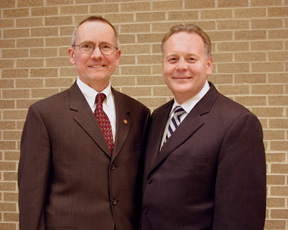 |
James Bramson, D.D.S., right, with John Reinhardt, D.D.S., dean of the UNMC College of Dentistry. In the late 1970s, Dr. Reinhardt was one of Dr. Bramson’s instructors in the operative dentistry department at the University of Iowa Dental School, where Dr. Bramson received his dental degree. “John is a great guy and a wonderful faculty member,” Dr. Bramson said. “When he called me and invited me to do this I couldn’t turn him down.” |
“Access to dental care, changes in the dentist-patient relationship and educating people about oral health – these are things you can effect if you get involved,” he said.
Dr. Bramson, executive director of the American Dental Association, was the guest speaker at the UNMC College of Dentistry’s 18th Annual Professionals’ Day March 19 at the East Campus Union in Lincoln. The event provides students, faculty and the dental community an opportunity to share professional and academic activities.
Following Dr. Bramson’s lecture, 48 dental and dental hygiene students were honored for their academic achievements.
The challenges that lie ahead for dental and dental hygiene students can be seen in the circumstances of today, Dr. Bramson said. “While the delivery of care is very strong, access to care is not,” Dr. Bramson said. “Eighty percent of dental decay occurs in about 25 percent of the children from underprivileged areas.”
It will be imperative for future dental students to continue to make sure regulators and lawmakers understand that oral health is also a part of general health. “The kind of dollars and support that insurance providers and lawmakers put into dental health pays in medical dividends,” Dr. Bramson said.
But, during the past 20 years, dentistry has become a smaller and smaller piece of the overall healthcare dollar, he said, adding that more and more dentistry is not paid for by insurance and Medicaid reimbursements are poor.
One solution, Dr. Bramson said, is a pilot program in Michigan that delivers care through a Medicaid system that is similar to private insurance. Through this program the community health center contracts with a private dental office, negotiates affordable fees and the health center takes care of the administrative red tape of the Medicaid system, leaving the dentist free to focus on delivering care.
Another challenge facing dental and dental hygiene students is the changing relationship between caregiver and patient. “Patients have so much access to information and come to the office well-educated about treatment opportunities,” he said. “They become more of a partner in their treatment.”
Thus, he said, dentists will need to be good communicators and become better at sorting out the credible, valid science that exists.
In the near future there will be a lot of emphasis on the growing link between oral disease and systemic disease, Dr. Bramson said. In fact, three or four major papers written in the last few years show a much closer association between oral disease and other medical issues, such as diabetes and coronary heart disease, he said.
“This knowledge will bring dentistry a lot closer to medicine,” Dr. Bramson said, “and changes us into more of an oral physician.”